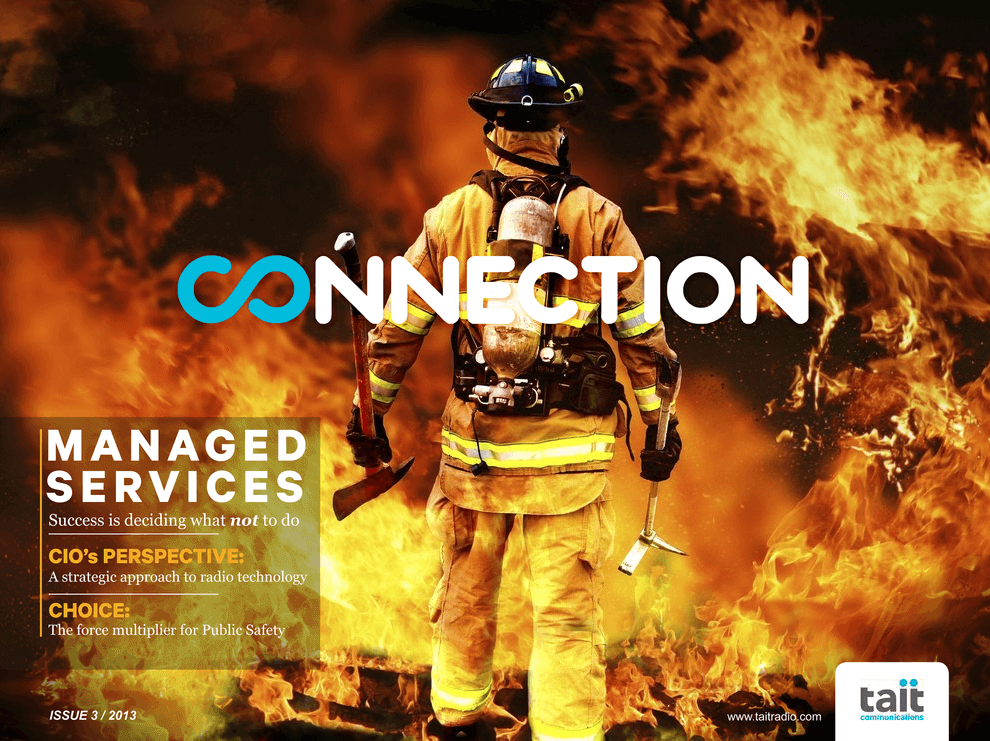In this two-part series,?John Emerson, Chief Information Officer at Tait Communications,?looks at what a CIO needs to know when considering a radio communication system.
Last week, in Part 1, we covered some of the important pieces of the radio communications puzzle that CIOs need to address, including, open standards, coverage and reliability. This week we look at the other aspects of radio systems that need to be considered. ?
Security With increasingly sophisticated and aggressive cyber-attacks, security has become a must-have. Not only is access security important, but high-level encryption has also become essential. Radio networks have very high security requirements, due to high government use, and are usually private, ensuring others cannot access transmissions as easily as they can on the public cellular network.
With increasingly sophisticated and aggressive cyber-attacks, security has become a must-have. Not only is access security important, but high-level encryption has also become essential. Radio networks have very high security requirements, due to high government use, and are usually private, ensuring others cannot access transmissions as easily as they can on the public cellular network.
The level of encryption within P25 networks is specifically designed for the higher requirements of law enforcement. As an example, the S?o Paulo Police Force?s effectiveness had been previously limited by drug cartels intercepting their communications and disappearing before police arrived. The Tait P25 network commissioned in 2006 has yet to be cracked by the crime syndicates and S?o Paulo Police recognized the contribution of the secure communications to a reduction in crime of 60 percent between 2006 and 2011.
Scalability
While Public Safety entities may not be physically expanding, regional mutual support agreements are becoming increasingly common. New networks tend to expand and replace the older networks, so that all parties can communicate by consolidating on one standard. Utility CIOs understand that their companies may expand by procuring other utility companies. Either way, a smart CIO is going to make sure that the communications network can be scaled up, to cover any eventuality.
Converging on the TCP/IP communications protocol, an organization?s networks can be managed from one console, irrespective of the content of the TCP/IP packet (voice, data, etc). Such convergence has already occurred in locations from a 60,000-resident city, to the Los Angeles basin with 14 million residents. The communications can involve any device (including desktop PCs, servers, smart phones, radios, traffic signals, etc). Many regions have mutual support agreements among police and fire, partly as a result of budget cutbacks, but also to be able to project a larger response in the event of a local disaster. Integrated communications platforms are essential to support coordinated, multi-organizational responses.
Management
To perform consistently, any network requires ongoing support. User administration, security, device monitoring and network monitoring are all key to maintaining network integrity and performance. CIOs will want an extensive network management tool to be able to perform management functions effectively over the long term.
The same network management tools used for managing IT networks can be used to manage the TCP/IP based radio networks. A network-addressable radio can be remotely checked for operational status, its location ascertained, software downloaded to it and operational issues identified before the radio is rendered inoperable if required. These are the same remote management tasks that can be performed with a smart phone, providing the ability to manage all the organization?s TCP/IP mobile devices in real time. Other functions that can be performed include device security and network performance management.
Redundancy in an emergency
While redundancy is built into most modern networks, the critical nature of Public Safety and utility work functions benefit from having multiple networks that provide additional redundancy. As most organizations already use the local public cellular network for a number of functions, in the event of a disaster, key staff can be issued with a radio. The radio network is a very cost-effective way to ensure the needs of an organization coping with an emergency are met, without the cellular network.
Interfaces
CIOs know that demands for integration will increase and that stand-alone systems are becoming rare. As radios become more intelligent and IP-based, interfaces with other networks (e.g. Wi-Fi) become common. Data interfaces with IT systems also become possible through these other networks. Any radio vendor not providing open-standard interfaces to other networks and IT systems risks losing sales, as potential customers walk away from probable vendor lock-in.
These days, that is probably a career-limiting decision.
The TCP/IP based radio networks can also be used as a ?bridge? to the organization?s other TCP/IP based systems from the open standards-based legacy radio networks. This may extend the life of the legacy networks and enable the expansion of the newer TCP/IP radio networks at an easier pace, avoiding the risky ?big bang? approach.
Convergence
Over the past 30 years, IT systems and networks have both become more complex to the point where they can be very difficult to manage. Organizations wonder why their IT departments can?t get anything done, when in fact IT staff work long hours to keep many different technologies going. CIOs are actively looking for ways to simplify their networks, systems and processes.
As can be seen in the comparison table, the commonality between networks is increasing to the point where network management tools can handle both internal IP networks and radio networks on the same console.
| Characteristic | Mobile Phone | IP Radio |
| Devices | iPhone, Android | Handheld radios |
| Robustness of devices | Low-medium | High |
| Hostile environments | Limited | Designed to function |
| Network | Commercial cell carriers | Radio frequency spectrum plus data network |
| Network customization | None; vendor only | Specific to customer, scalable |
| Coverage | 90% | 99+% |
| Data bandwidth | Medium | Medium |
| Standards | IP | IP |
| Security | Encryption, Authentication | Encryption, key management, radio authentication |
| Remote monitoring | Separate purchase | Available as an option |
| Network management | None; vendor only | Standard |
| Analog network option | None | Yes |
| GPS | Yes | Yes |
| VoIP interface | Yes | Yes |
| SNMP support | Yes | Yes |
| Wi-Fi support | Yes | Yes |
| Bluetooth support | Yes | Yes |
| Lifecycle | 2- 4 years | 10 ? 12 years |
Cost effectiveness/lifecycle
Continual downward pressure on IT budgets and increasing demands for service can mean being the CIO is a thankless task these days. Predictable cost is essential, as well as reasonable component cost, so that there are no surprises. As radio technology is built to last more than three times as long as cellular, cost can be spread over a much longer lifecycle of 10 to 12 years.
Radio is relevant
Converging technologies between IT and the critical communications that radio networks support mean that it?s actually more closely aligned with the CIO?s domain than ever before.
Contrary to widely held beliefs, radio is by no means past its prime.
Radio has evolved significantly, and will continue to play an essential role in Public Safety and utility organizations that require mission-critical communications across challenging coverage areas. When issues such as coverage, reliability, security, robustness and cost are fully considered, a radio network offers genuine business value to many organizations.
Natural disasters
When a natural disaster strikes, commercial telecommunications company networks are immediately impacted. Cellular providers told the Federal Communications Commission that the day after Hurricane Sandy landed on October 29, 2012, more than 25 percent of cellphone service went out in the 158 counties across the 10 states most affected by the storm. Services worsened in many areas as generators serving cell towers ran out of fuel. Entire households were without communication as their bundled services (mobile phone, Internet and landline) failed completely.
In February 2011, When a Richter 6.3 earthquake struck Christchurch, New Zealand, with the third largest shock force ever recorded, the telecommunications networks were severely damaged and there was low availability within the city. The radio networks used by Public Safety agencies were quickly restored and continued to perform throughout the following aftershocks.
These examples highlight the importance of having secure, highly reliable radio networks dedicated to public safety use, capable of integrating with and operating across different technologies within a regional area.
 This extract is taken from?Connection Magazine, Edition 3. Connection is a collection of educational and thought-leading articles focusing on critical communications, wireless and radio technology.
This extract is taken from?Connection Magazine, Edition 3. Connection is a collection of educational and thought-leading articles focusing on critical communications, wireless and radio technology.
Share your views, comments and suggestions in the?Tait Connection Magazine LinkedIn group.
Like this:
Loading...
Lolo Jones Steve Gleason blake shelton sofia vergara LIRR nhl Espn Nba
No comments:
Post a Comment
Note: Only a member of this blog may post a comment.